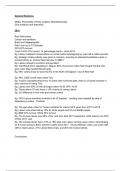Other
UK General Elections
- Course
- Institution
In depth lists of General Elections in the UK, including 2019, 1997, 1983 and 2017. Includes conclusions about eat GE, includes subheadings eg. 'Media' and lists evidence of impact. Also points out key information of the GE, context and key factors.
[Show more]



